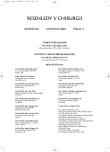Anterior Spondylodesis Using a Corticospongious Allograft in the Combined Management of Th-L Spinal Fractures
Authors:
A. Bilik; J. Kočiš; P. Wendsche; V. Mužík; L. Paša
Authors‘ workplace:
Klinika traumatologie LF MU v Úrazové nemocnici Brno přednosta: prof. MUDr. P. Wendsche, CSc.
ředitel: prof. MUDr. M. Janeček, CSc.
Published in:
Rozhl. Chir., 2006, roč. 85, č. 11, s. 573-580.
Category:
Monothematic special - Original
Overview
Aim:
The authors introduce a group of patients with thoracolumbar spinal fractures, following their combined management. The aim of this work is to retrospectively assess the allograft bone reconstruction and loss of spinal axis correction rate in the fused segments, following extraction of the posterior instrumentation.
Material:
During the period from 2002 to 2005, the authors managed 71 patients with spinal fractures in Th 11-12 segments, using the combined procedure, excluding anterior fixation, in the Traumatology Clinic of LF MU Brno. The study group included 37 patients, at least 6 months after extraction of the posterior stabilizator. The patient group included 12 females and 25 males, aged between 17 to 62 years. The mean age was 29.7 years.
Methods:
The patients were managed with transpedicular stabilization method as the first step and with anterior monosegmental spondylodesis using coticospongious allografts, excluding futher use of metal implants, as the second step. Assessment of the bone reconstruction and incorporation of the allograft at the anterior spondylodesis site, was based on x-ray and CT examinations.
Loss of correction in the fused segment was assessed based on measurement of GDW angles (Grund-Deckplattenwinkel) on x-rays following extraction of the implant. The findings were compared to those following stabilization. Upon CT examination, bone structure of the implanted allograft and its reconstruction and incorporation between the two vertebrae, was assessed. Furthermore, the concerned bone density was measured.
Results:
Out of our patient group, no loss of correction was detected in five subjects, only. In 32 subjects, the correction loss ranged from 1° up to 34°. The mean was 7.08°. Based on the CT examination, partial resorption of the graft edge occured in all subjects, in 32 subjects the allograft was fragmented , particullarly in its central part, with densities ranging from 122 HU
to 246 HU, the mean of 158 HU. The graft’s outline was partially undetectable in 20 subjects. Outer hypodense zone surrounding
the allograft was detected in all subjects.
Discussion:
Injured discs next to the injured vertebra undergo degeneration and, later on, collaps, which results in the correction loss. Therefore, fusion of the segments is an essential part of stabilization procedures. Either posterolateral fusion, interintraarticular
fusion or anterior intercorporal fusion methods may be applied. The authors concentrate primarily on adequate completion of the anterior fusion, which may prevent a serious secondary complication – posttraumatic kyphosis. However, opinions on management of the anterior segments and anterior spondylodesis, are not uniform. Also, best methods which would result in firm spondylodeses, are currently under discussion.
Conclusion:
The aim of the anterior column therapy is to create anterior spondylodesis firm enough to prevent future onset of a posttraumatic kyphosis. Anterior fusion based on conticospongious allografts without anterior instrumentation may frequently result in kyphotic spinal deformities, due to its partial resorption and fragmentation. Therefore, the authors would not recommend using corticospongious allografts without anterior instrumentation.
Key words:
fusion – allograft – loss of correction – bone healing
Labels
Surgery Orthopaedics Trauma surgeryArticle was published in
Perspectives in Surgery

2006 Issue 11
Most read in this issue
- Anterior Spondylodesis Using a Corticospongious Allograft in the Combined Management of Th-L Spinal Fractures
- Late Hematogenic Infection of Joint Replacements and Its Prevention in Surgery
- Compound Depressed Fracture of Occipital Bone Causing Laceration of Left Occipital Lobe and Injury of Superior Sagittal Sinus – Case Report
- Long-Term Results of Microsurgical Varicocelectomy
